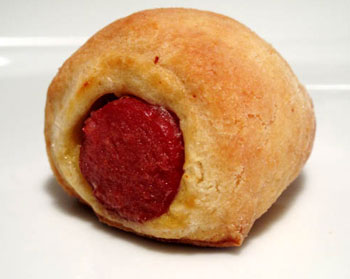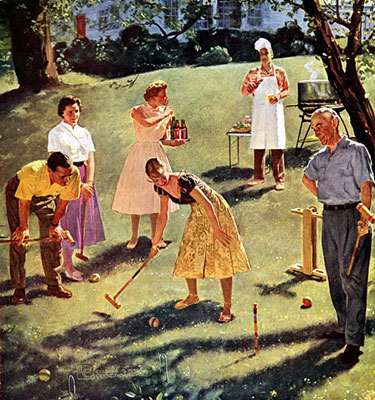|
These are always a big hit at parties, so I when I saw this recipe on Cook’s Country I knew I had to try them. The most common method is to use store bought crescent dough or puff pastry, but the crust used here is based on a cream biscuit recipe. You can make them ahead and keep them in the freezer until ready to bake.
Line rimmed baking sheet with parchment paper. Pulse 2 cups flour, shortening, baking powder, salt, and cayenne in food processor until the mixture resembles coarse meal. Transfer to large bowl. Stir in cream until combined. Turn onto lightly floured surface and knead dough until smooth, 8 to 10 times. Roll dough into 15- by 10-inch rectangle. Brush dough with egg wash and cut into six 5-inch squares. Place remaining flour in shallow dish. Pat hot dogs dry with paper towels and coat with flour, shaking off excess. Arrange 1 hot dog in center of each dough square. Roll dough around hot dog and pinch seam closed. Cut each hot dog into 4 rounds and place on prepared baking sheet. Freeze until firm, about 30 minutes. Transfer to zipper-lock bag and freeze for up to 1 month. Adjust oven rack to middle position and heat oven to 425 degrees. Arrange rounds, seam side down, on parchment-lined rimmed baking sheet. Bake until golden brown, 25 to 30 minutes. Let cool 10 minutes. Serve warm. – Recipe courtesy of Cook Like James |
Retro Recipes and Traditional Fare
Retro Recipes and Traditional Fare
Romesco Sauce Suzanne Goin Style
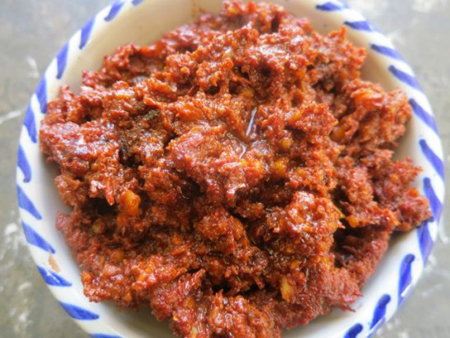 This is one of those recipes that seems more complicated than it is. Make it once and you’ll never need to look at the recipe again. Eat what you make and you’ll become addicted, learning new ways to use the nutty, spicy, sweet, deeply satisfying condiment. It’s a no brainer on simple grilled, broiled or poached fish or chicken, but it’s on vegetables where the sauce really shines.
This is one of those recipes that seems more complicated than it is. Make it once and you’ll never need to look at the recipe again. Eat what you make and you’ll become addicted, learning new ways to use the nutty, spicy, sweet, deeply satisfying condiment. It’s a no brainer on simple grilled, broiled or poached fish or chicken, but it’s on vegetables where the sauce really shines.
Suzanne famously serves it atop potatoes. I’ve featured it here on this blog as part of a Grand Aioli, a dish where dipping becomes an art form of customization. I love it dribbled on fried eggs, tucked in a tortilla with whatever as a “colonial” salsa. I would really like to know your favorite way to eat Romesco. A spoon anyone?
If you can’t find dried chiles pasillas then substitute the more commonly found New Mexico chiles. Pasillas have a more complex sort of winy flavor and a bit more heat than the brighter flavored New Mexico chile.
This is one of those recipes where the quality of the bread makes a tremendous difference. It’s a peasant dish and assumes a peasant loaf, so try to find a great natural local natural yeasted bread in your area. If all else fails, use La Brea Bakery. I used a couple slices off a small boule from Roan Mills.
Blackberry Upside Down Cake
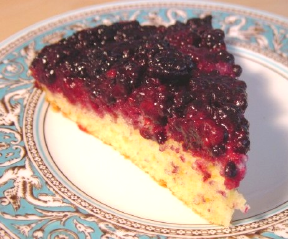 When a wine is described as "jammy" I always think of blackberries. Rich, ripe, fruity flavors so intense they almost taste more cooked than fresh. Blackberries, when fully ripe and sweet, not sour, taste like jam to me. Jammy also means "lucky" according to an Australian English dictionary I recently consulted. I think one slice of this cake will make you feel very lucky indeed! I certainly feel lucky to have gotten the berries from my friend Alton who brought them back from his mountain cabin hideaway, Shadow Woods.
When a wine is described as "jammy" I always think of blackberries. Rich, ripe, fruity flavors so intense they almost taste more cooked than fresh. Blackberries, when fully ripe and sweet, not sour, taste like jam to me. Jammy also means "lucky" according to an Australian English dictionary I recently consulted. I think one slice of this cake will make you feel very lucky indeed! I certainly feel lucky to have gotten the berries from my friend Alton who brought them back from his mountain cabin hideaway, Shadow Woods.
I'm assuming since you are visiting this site, that you probably use the internet to find recipes. I sure do. One thing I particularly find useful are the reader comments. For example the recipes on Epicurious often have suggestions from readers on changes and improvements they have made to the posted recipes. Sometimes their suggestions make sense, though not always.
This recipe started out as one I found online, but based on reader comments, a little experimenting, and ultimately my own experience I made it my own. How different is it from the original?
Perfect Hash Browns
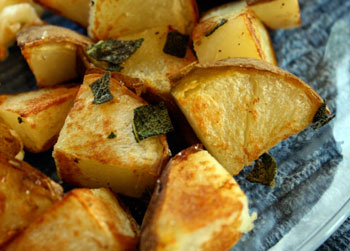 I found the secret to the crispiest, most delicious home fries.
I found the secret to the crispiest, most delicious home fries.
It all started with a late night binge. I was still hungry (or maybe just bored…) after dinner one night, so I decided to make a baked potato. While I was waiting, I snacked on about a million other things, and when my potato was ready, I wasn’t hungry anymore. The potato spent the night in the fridge.
While I was thinking about breakfast the next morning, I decided to see what I could whip up with the potato…and wow, if you want a quick and easy breakfast side, this is the way to go!
Chex Mix Cha Cha
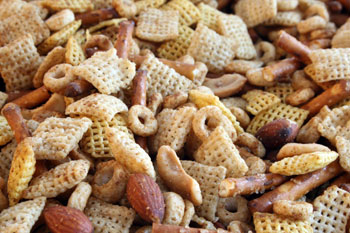 Chex Mix. It’s one of the simple things of life.
Chex Mix. It’s one of the simple things of life.
It seems to me Chex Mix has been around forever. I remember my mom mixing up a batch or two each year at Christmas time, following the directions on the box. I also clearly remember all the Wheat Chex remaining at the bottom of the bowl. No one seemed to care for those dark pieces, yet the Wheat Chex always went into the mix.
About 10 years ago, I got gutsy and broke my mother’s Chex Mix mold. I left out the Wheat Chex. I stirred in some Cheerios instead. I changed the seasoning ingredients. Nothing left in the bottom of the bowl any more. After making it at Christmas time and for Super Bowl games for a few years, I forgot all about that mix my family gobbled up each time I made it.
A couple of weeks before Christmas I was staying with my son and daughter-in-law in Fargo for a weekend. I noticed my daughter-in-law had a recipe on the counter for Chex Mix Cha Cha. She had gotten the recipe from me. I’m not sure how I could have totally forgotten about it. I copied it, feeling very uncertain about where I would look for it in my own recipe collection.
More Articles ...
Welcome to the new One for the Table ...
Our Home Page will be different each time you arrive.
We're sure you'll find something to pique your interest...

